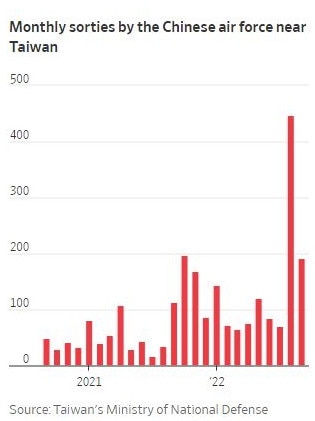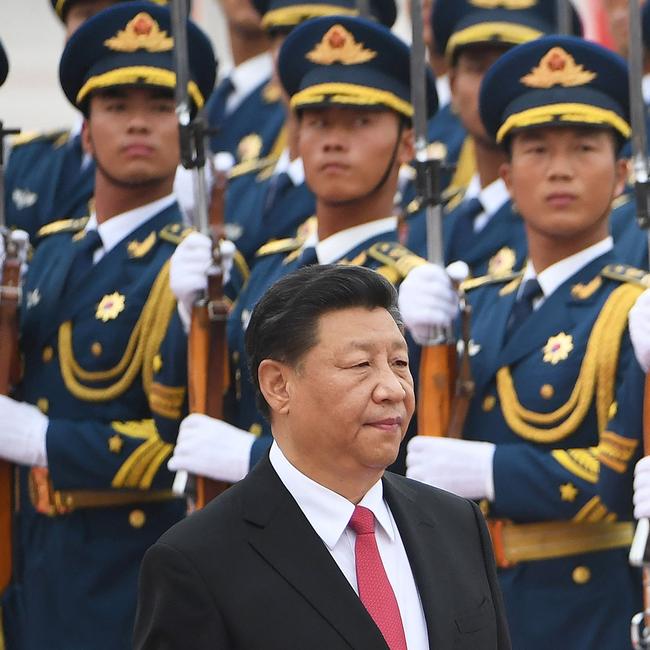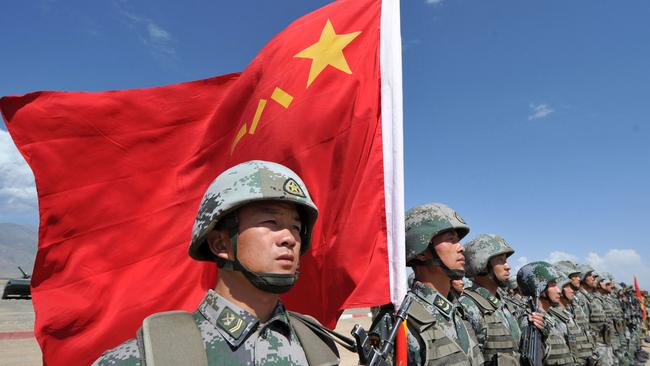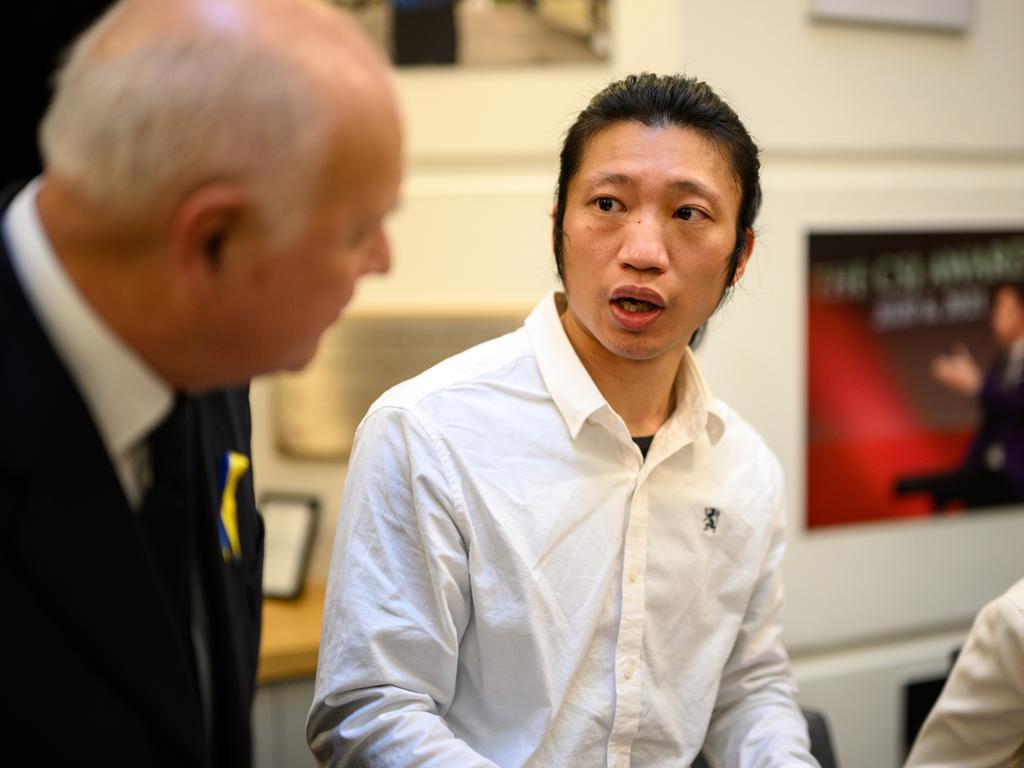China’s military is catching up to the US … is it ready to fight?
The People’s Liberation Army is emerging as a true competitor to the US amid heightened tensions with Taiwan. The challenge for Xi Jinping is preparing troops to fight.

China’s military is emerging as a true competitor to the US under Xi Jinping. The People’s Liberation Army now has hypersonic missiles that evade most defences, a technology the US is still developing. Its attack drones can swarm to paralyse communications networks. China’s naval ships outnumber America’s, and it launched its third aircraft carrier this summer, the first to be designed and built in the country. Its defence budget is second only to the US’s. China’s military has more serving members, at around 2 million, compared with just under 1.4 million in the US.
The question for Mr Xi, which he has raised in public, is whether those forces are ready for battle.
China hasn’t fought a war since a brief border clash with Vietnam in 1979. Unlike American forces, who have fought for most of the past two decades in Iraq and Afghanistan, China’s service members have virtually no combat experience — which some Chinese leaders have referred to as a “peace disease”. Finding a solution short of actual war has been a priority for Mr Xi, especially as he seeks to prepare the country for a potential showdown with the US.
“We must comprehensively strengthen military training and preparation, and improve the army’s ability to win,” Mr Xi said on Sunday at the opening of the Communist Party’s twice-a-decade congress.
“The complete unification of the motherland must be realised, and it will be realised,” he said, drawing loud applause.
Taiwan reported few sorties by the Chinese air force close to the island before 2020. It says they have reached more than 1200 so far this year. After Democratic House Speaker Nancy Pelosi visited Taipei in August, angering Beijing, Chinese military aircraft began crossing the median line between Taiwan and the Chinese mainland on an almost daily basis.
Beijing’s state media reported an increase in more qualified recruits to the PLA after Mrs. Pelosi’s visit.

Yet PLA publications say some officers make flawed operational decisions, struggle to lead their troops and sometimes don’t understand their own orders. Rank-and-file troops are caught in a top-down system of command, potentially leaving them ill-equipped to improvise in battlefield situations — a situation that has hobbled Russia’s military in its invasion of Ukraine.
China’s political priorities mean that around 40 per cent of new recruits’ training has involved studying about the Communist Party rather than learning how to be a service member. Leaders, some of whom see young Chinese as pampered products of the country’s one-child policy, question whether they are tough enough to fight.
An effort to make China’s different military branches work more closely together — so-called “jointness,” which is considered crucial to modern warfare — remains untested.
“At present, there are not many commanders in the PLA who are truly proficient in joint combat,” one serving officer at the Zhengzhou Joint Logistics Support Center wrote earlier this year in a commentary in the PLA Daily, the military’s newspaper. “If this situation does not change, once there is a war, it will be very dangerous.” Outside analysts say the PLA appears to be making progress in bringing forces together for more complex joint exercises, helped by interaction with other militaries, especially Russia’s. Since Mr Xi took power, China has increased drills with Russia to as many as 10 a year from one or two previously.
“We are observing an increasing complexity and sophistication in how they are performing in exercises,” said Oriana Skylar Mastro, who researches the Chinese military at Stanford University.

Mr Xi’s ambition, according to China’s most recent defence white paper, is to complete a modernisation of the military by 2035 and turn it into a “world-class force” by 2049, the 100th anniversary of the ruling Communist Party’s founding.
Strategists outside China say the PLA’s short-range missile, air and naval power is now so well developed that it would be nearly impossible for other countries’ militaries to operate near China’s shoreline in a conflict.
Beijing’s cyberwar capabilities are widely considered to be state-of-the-art. The US Office of the Director of National Intelligence, which advises the president on national security, said in a report this year that China is almost certainly capable of launching cyberattacks that would disrupt critical infrastructure in the US, including oil and gas pipelines and rail systems.
Hundreds of millions of dollars spent on ballistic missile technology mean that China can now put US bases in Asia under threat. A growing nuclear arsenal is providing Beijing with the means to better deter rivals.
Occasional reports of training missteps or incompetence occasionally surface in state media. Like other militaries, the PLA puts together exercises in which its own forces play the part of rivals. In China, these are known as Blue teams, a colour representing NATO. The PLA teams are red, the colour of China’s flag.
In one 2014 exercise in Inner Mongolia described in state media, the Blue team decided to trick the Red team by sending around 20 troops disguised as members of a friendly local government group, with offerings of cabbages, potatoes and drinks.
It worked. The Red team brought them to their headquarters, where the impostors pulled out weapons and captured the Red commander.
In another case reported in state media, an army battalion commander issued an incorrect order to fire shorter-range artillery when long-range fire was needed. The shots fell short, enabling a Blue armoured helicopter to find and destroy the Red position.

A PLA Daily account from last year described how the leaders of a brigade were given night vision equipment ahead of an exercise. They didn’t know what it was, and failed to distribute it to their troops.
Such mistakes aren’t exclusive to China, but they have fuelled insecurity among leaders, who have repeatedly used the phrase “five incapables” to describe PLA failings in speeches and commentaries in China’s military press.
The phrase refers to fears that PLA officers cannot judge situations, understand higher authorities’ intentions, make operational decisions, deploy troops, or deal with unexpected circumstances.
Another common phrase of self-criticism, the “two inabilities,” refers to a perceived inability of the PLA to fight a modern war and the inability of PLA officers to command.
Mr. Xi has been trying to rectify those problems since he came to power in 2012. In 2015, he launched China’s most ambitious military reforms in decades. He overhauled the organisational structure of the PLA with the goal of allowing its armed services — army, navy, air force and rocket and support forces — to work more closely together. Such coordination would likely be needed for major operations such as an invasion of Taiwan.
Mr Xi also expanded the PLA’s budget, created new special operations units and stepped up efforts to draw in more qualified service members.
Beijing extended free healthcare to troops and their families, improved military canteens and encouraged putting popular boy band members in military propaganda to drive recruitment.
Central to the PLA’s issues, defence experts say, is a shortage of high-quality talent, including for officers.
In the US, competition to get into West Point or one of the other four military academies for officer training is intense. But in China, average scores on standardised admissions tests for those accepted into its military academies over the past few years fell well below those accepted into the most well-regarded universities.
The lowest successful scores at China’s prestigious Tsinghua University in 2021 were in many cases nearly 10 per cent higher than at the National University of Defence Technology, often referred to in China as the military Tsinghua.
As a wing of the Communist Party, the PLA is subject to demands from political leaders. In 2021, the Ministry of Education said the role of the military was to provide jobs for young Chinese. Recruitment is skewed heavily toward poorer rural areas, which tend to have lower educational standards and higher unemployment.
Unlike the US, the PLA lacks a well-established system for bringing in and retaining talented noncommissioned officers, the backbone of most militaries. NCOs are usually high-school graduates who rise through the enlisted service to help execute orders and manage the lower ranks.

China has tried to make NCO roles more attractive. One program allows recruits to continue studies at a college or vocational school for 2-1/2 years before entering the military, and covers some of the cost, to better qualify them for civilian jobs after military service.
Just over 20,000 students enrolled in the program in 2020, according to official data, a fraction of the overall NCO corps. This year, China said it would add better benefits.
Military analysts say the PLA does have some highly proficient service members, including units similar to US Navy Seals and Air Force commandos.
Mr Xi has intensified efforts to make military drills more realistic and complex. Before he took power, exercises were sometimes seen by outside analysts as little more than performances to make the military look good. Now they more often provide some of the closest simulations to real-world combat available, military analysts say.
Last year, the PLA’s air force and army took part in the first major joint exercises with Russia inside China, involving more than 10,000 personnel. The drills included airborne troop assaults, drone attacks and precision fighter jet strikes, according to official reports.
Dennis Blasko, a retired US Army lieutenant colonel who was a military attaché in Beijing in the 1990s, says force-on-force training is usually held by the PLA for relatively short periods such as a day or few days, which wouldn’t prepare it for a prolonged war.
The true test of PLA personnel will be when they’re called on to fight. Some American military strategists and analysts say China might be a generation away from having the ability and training in its military that could effectively match those of the US.
“Our staffs have been doing extended combined operations for decades. Theirs haven’t,” Mr Blasko said.
The Wall Street Journal





To join the conversation, please log in. Don't have an account? Register
Join the conversation, you are commenting as Logout